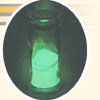

 |
|
 |
     |
The Mystery of the Rays Read more about the mystery of the rays here. First Marie needed a lab. She had to
settle for a storeroom in the Paris Municipal School, where her husband,
Pierre Curie, was now a professor. The storeroom was crowded and damp,
but somehow she had to overcome its problems. She started off by studying
a variety of chemical compounds that contained uranium. She discovered
that the strength of the rays that came out depended only on the amount
of uranium in the compound. It had nothing to do with whether the material
was solid or powdered, dry or wet, pure or combined with other chemical
elements.
If you had a certain amount of uranium—a certain number of uranium
atoms—then
you got a certain intensity of radiation. Nothing else made a difference. |
 |